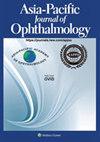基于角膜变形的人工智能早期圆锥角膜局部生物力学改变检测。
IF 4.5
3区 医学
Q1 OPHTHALMOLOGY
引用次数: 0
摘要
目的:基于动态变形视频,利用机器学习技术检测局部角膜生物力学变化,建立早期圆锥角膜诊断新方法。设计:诊断性研究。方法:选取2015年2月6日至2022年8月25日期间来自天津眼科医院(中国天津)和山西眼科医院(中国西安)的917个角膜视频。利用Scheimpflug技术获得了在强制充气作用下的动态变形视频。通过对视频中提取的115,200像素点的角膜轮廓进行样条曲线拟合,计算出14个新的像素级生物力学参数,以表征局部生物力学特征。建立集成学习模型,进行外部验证,并与现有临床诊断指标的诊断效果进行比较。使用精确度、召回率、F1分数和接收者工作特征曲线下的面积来评估所开发的机器学习模型的性能。结果:集成学习模型成功诊断出早期圆锥角膜(曲线下面积= 0.9997),准确率为95.73%,召回率为95.61%,样本集(n=802) F1评分为95.50%。在独立数据集(n=115)上进行外部验证,准确率为91.38%,召回率为92.11%,F1得分为91.18%。结论:动态变形视频结合机器学习算法检测局部角膜生物力学变化对早期圆锥角膜的诊断有一定的帮助。关注局部的生物力学变化可以指导眼科医生,帮助早期圆锥角膜的及时诊断,有利于患者的视力。本文章由计算机程序翻译,如有差异,请以英文原文为准。
Localized Corneal Biomechanical Alteration Detected In Early Keratoconus Based on Corneal Deformation Using Artificial Intelligence
Purpose:
This study aimed to develop a novel method to diagnose early keratoconus by detecting localized corneal biomechanical changes based on dynamic deformation videos using machine learning.
Design:
Diagnostic research study.
Methods:
We included 917 corneal videos from the Tianjin Eye Hospital (Tianjin, China) and Shanxi Eye Hospital (Xi'an, China) from February 6, 2015, to August 25, 2022. Scheimpflug technology was used to obtain dynamic deformation videos under forced puffs of air. Fourteen new pixel-level biomechanical parameters were calculated based on a spline curve equation fitting by 115,200-pixel points from the corneal contour extracted from videos to characterize localized biomechanics. An ensemble learning model was developed, external validation was performed, and the diagnostic performance was compared with that of existing clinical diagnostic indices. The performance of the developed machine learning model was evaluated using precision, recall, F1 score, and the area under the receiver operating characteristic curve.
Results:
The ensemble learning model successfully diagnosed early keratoconus (area under the curve = 0.9997) with 95.73% precision, 95.61% recall, and 95.50% F1 score in the sample set (n=802). External validation on an independent dataset (n=115) achieved 91.38% precision, 92.11% recall, and 91.18% F1 score. Diagnostic accuracy was significantly better than that of existing clinical diagnostic indices (from 86.28% to 93.36%, all P<0.01).
Conclusions:
Localized corneal biomechanical changes detected using dynamic deformation videos combined with machine learning algorithms were useful for diagnosing early keratoconus. Focusing on localized biomechanical changes may guide ophthalmologists, aiding the timely diagnosis of early keratoconus and benefiting the patient's vision.
求助全文
通过发布文献求助,成功后即可免费获取论文全文。
去求助
来源期刊

Asia-Pacific Journal of Ophthalmology
OPHTHALMOLOGY-
CiteScore
8.10
自引率
18.20%
发文量
197
审稿时长
6 weeks
期刊介绍:
The Asia-Pacific Journal of Ophthalmology, a bimonthly, peer-reviewed online scientific publication, is an official publication of the Asia-Pacific Academy of Ophthalmology (APAO), a supranational organization which is committed to research, training, learning, publication and knowledge and skill transfers in ophthalmology and visual sciences. The Asia-Pacific Journal of Ophthalmology welcomes review articles on currently hot topics, original, previously unpublished manuscripts describing clinical investigations, clinical observations and clinically relevant laboratory investigations, as well as .perspectives containing personal viewpoints on topics with broad interests. Editorials are published by invitation only. Case reports are generally not considered. The Asia-Pacific Journal of Ophthalmology covers 16 subspecialties and is freely circulated among individual members of the APAO’s member societies, which amounts to a potential readership of over 50,000.
 求助内容:
求助内容: 应助结果提醒方式:
应助结果提醒方式:


